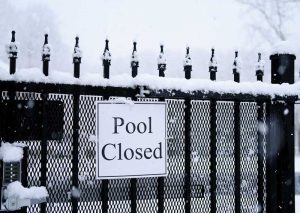
Water balance, sanitizer residual, and water clarity should all be evaluated and balanced before a pool is closed. Clearing up problems before closing allows the winterizing program to work effectively, and helps open the pool quickly and easily in the spring.
Water balance should be considered first when winterizing a pool—pH, total alkalinity (TA), and calcium hardness should all be balanced to ideal parameters. Winter temperatures bring colder water, which can lead to a corrosive environment. Prolonged exposure of corrosive water to the pool’s surfaces may cause etching and metal staining to become more prominent on pool surfaces; it can also lead to potential damage to pool equipment.
In addition to balancing the pool water before closing, a stain and scale control product should be added at closing to protect the pool from surface problems and metal-based staining or water discoloration. These products are a great combination to provide superior protection over the course of winter as they get the pool started off in the right way when summers rolls around again.
A chlorine residual is important to maintain when closing the pool. Establishing a 1 to 4 ppm residual before adding winterizing chemicals is ideal, as the longer a residual is maintained, the easier spring opening will be. If no residual is present at closing, the pool is likely to experience chlorine demand at opening. This contamination buildup in the water can consume larger than typical amounts of chlorine and make it difficult to establish a residual. If a pool is closed while experiencing a chlorine demand, the water is likely to be cloudy or problematic when opening. The contamination will go unchecked during the winter, and bacteria and algae will grow in the absence of a chlorine residual. This will lead to a more substantial demand upon opening and increased amounts of chlorine to establish a residual at spring opening. Chlorine demand must be addressed and corrected before winterization.
Enhancing the winterization process
There are many options for winterizing chemicals and winter kits are available when it is time for closing. Regardless of which kit you choose, all pools should be brushed and vacuumed, and shocked with a chlorine oxidizer before closing. In addition to the basics, however, there are many other specialty options to enhance the winterizing process.






